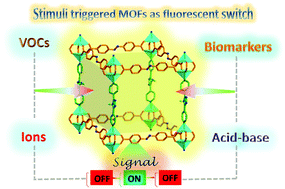Stimuli -triggered fluoro-switching in metal–organic frameworks: applications and outlook
Abstract
The design and synthesis of efficient sensor materials with fast-responsive and ultrasensitive detection ability is critical to monitor ecological safety, supervise human health, control industrial wastes, and govern food quality among others. Metal–organic frameworks (MOFs) or coordination polymers (CPs) are a new class of porous crystalline materials that have emerged in several potential applications in last two decades. In particular, applications of MOFs as sensory scaffolds for the detection of hazardous pollutants have attracted researchers due to their fabulous structural characteristics and wide range of pore environment tunability. Among several transducer procedures, the luminescence detection of a particular analyte is immensely desirable as it is easy to handle and cost effective, where visual changes in physicochemical attributes can be comprehended via a quick naked eye detection. The porous nature of MOFs facilitates the pre-concentration of target analytes within the pore structure and provides superior host–guest interaction with good detection limits when compared to conventional materials. To this end, guest-induced fluorescence switching in sensory MOFs with good recyclability and unique detectable fingerprints are of particular importance to benefit futuristic monitoring aptitudes and promises environmental remediation. In this review, we present the latest literature based on the analyte-responsive modulation of fluorescence intensity in MOFs towards the detection of target pollutants and discuss the underlying sensing mechanism, which can assist in developing new useful nano-scale devices and sensors.

- This article is part of the themed collection: 2021 Frontier and Perspective articles


 Please wait while we load your content...
Please wait while we load your content...